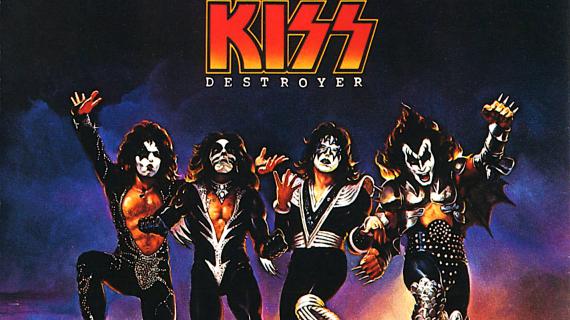I was a musician before I got into advertising. I spent seven years gigging, touring, singing, writing, performing and trying to make it as a rock star—a folk-rock star, to be precise. Clearly, it didn't happen, but those years on the road were formative. In fact, much of what I learned playing in a band I've brought to advertising; feeling comfortable in front of an audience, the value of interpersonal skills, that song writing is a lot like copywriting, and an entrepreneurial spirit.
I say "folk-rock star" because it was that music I listened to and that inspired my own music. Mind you, I listened to everything, but it was the confluence of acoustic, electric, harmonies, poetic songwriting, and just a peaceful easy feeling of which that genre evoked, and I was drawn to it.
My top 10 album covers are a combination of the very albums that were pivotal in my becoming a singer-songwriter, plus a few albums that are as eye-catching as they are toe-tapping. Covers that broke-through. Covers that told old a story. And some, folk-rock or not, that are simply worthy of any top 10 list.
Crosby Stills, Nash & Young
So Far (1974)
First, I love the name for this "Greatest Hits" album, i.e. "we're not done yet"—the copywriting alone would put it in my top 10 list. But from an artwork perspective it's well, a piece of art. Painted by Joni Mitchell, a fellow Canadian and folk icon in her own right, she was a friend of the band and was asked to paint the cover. The silhouettes of each member of the band, their instruments and the landscape around them is painted in a folk-art manner, evocative of their music, their lyrics, and of the time. Such a great cover, such a great album.
Grateful Dead
American Beauty (1970)
Love this cover. The type is born right out of the psychedelic era it was released in. The rose in the middle, stylized by Mouse-Kelly, one of the era's more important artist duos, became an icon for the band. And the wood background sets the stage for this predominantly folky/country studio album (arguably their best studio effort). Love the simple background and centered composition, drawing your eye to the very heart of the cover, and the album. Every song is a winner, much like the cover. (Note: This album was inspired by, you guessed it, Crosby, Still, Nash, & Young).
Taylor Swift
Red (Taylor's Version) (2021)
Taylor's version of Red is right in the wheelhouse for me, lyrically and musically. We see here on the left the OG Red album released in 2012, and the re-released version in 2021, on the right. (Note: Another Joni Mitchell reference; Joni's Blue album inspired Taylor's Red album.) Of course, Taylor, in an incredibly savvy marketing move, re-released two of her albums to gain ownership rights to her music—so smart. Anyways, love that the only color "red" on her first album cover is her lipstick. And I love that the re-released album cover still has the red lips, but now you see more of her face. You see her fully, as if to say "This is the true me." I love the meaning behind that.
Pink Floyd
Wish You Were Here (1975)
"Wish You Were Here" was/is a classic Pink Floyd song every new guitar player learned to play. And when you sat down to figure it out, you pulled out the album and couldn't help but stop and stare at the burning man. Shot on the Warner Brothers Studio set by Storm Thorgerson, the renowned graphic designer and resident Pink Floyd album cover designer, the burning handshake was inspired by the idea that people tend to conceal their true feelings, for fear of "getting burned," in this case, two businessmen. Aside from the striking visual and the comment on society, that little burnt edge in the top right, bleeding out of the framed image is well, fire.
Van Halen
1984 (1984)
Now, '80s rock is a far cry from the folk-rock genre but still, "Jump?!" I mean c'mon, it's a classic amongst any genre! And this album cover is also a classic. The album featured the band's only #1 single on the Billboard 100, the aforementioned "Jump." It also featured an innocent blonde-headed child, seemingly naked, with angelic wings on the cover—and smoking a dart, with a couple of packs still to get through! It was the right amount of edge for a band that was just on the edge of the hardest of rock. The image of an angelic child smoking a cigarette stood out on shelves, and in the hearts and minds of all hair-band lovers!
Kenny Rogers
The Gambler (1978)
"The Gambler." A karaoke classic and Kenny Rogers' signature song. In fact, the first concert my father ever took me to was Kenny Rogers. This song was on repeat at the Miller household when I was a kid. The song has this storytelling quality to it—and so did the album cover. It was a visual story in and of itself, taking place in a turn of the century saloon. Complete with all the trappings of what you might find in such a place, and at such a time. The album cover was a visual representation of the title track. Just by looking at it, you could hear the song coming through—you might even be singing it to yourself right now…
Poco
Seven (1974)
Poco was a little-known band born out of that 1970s California Sound—think The Eagles, Buffalo Springfield, The Byrds, etc. In fact, members of all those bands at one point had a role in and out of Poco. Of all their album covers, this was my favorite, purely from a design aesthetic. The color palette works perfectly. The "Poco" typeface is apt for their folk-country genre (notice the woodcut detail). And the horseshoe is iconic of that same genre and adds an element of luck, while framing the band's name, and album name, lucky number "Seven," perfectly.
Coldplay
X&Y (2005)
Even without knowing what the hell the Baudet Code is, let alone how to decipher it, Coldplay's X&Y album cover needs no decoding. Everything about the cover is much like the music; engaging, simple in its execution, and smart. Even though the combination of blocks is spelling X&Y—yes, in the Baudet Code— it's a perfectly balanced shape. The colors too are perfectly balanced, even the black, grey and white. And against that blue background, it all just works. You stare at it. It makes you think. It makes your mind wander. And it draws you in, just as this album did, reaching #1 in 32 different countries.
The Beatles
Sgt. Pepper's Lonely Hearts Club Band (1967)
I mean, where do you begin with this one! I loved this cover more than I did the music within, to be honest, although the title track is a banger. The cover has so much going on; visually, philosophically, metaphorically, literally, laterally, and literally, as the kids say. I'd spend hours trying to figure out the audience behind the band. Who they were. Why they were. It was the first album launched after the Beatles took a hiatus from touring. It was a renewal of sorts, musically but also as a group, as seen by their own predecessors standing to the renewed band's left. In fact, the cover ended up winning a Grammy in 1967 (guess I wasn't the only one who liked it.)
The Rustic Gomers
Lost Lake (1994)
I couldn't do an album cover review without reviewing my own band's cover! The early members of the band would go camping every third week in August up at Lost Lake, in northern Ontario. Five guys, two tents, fishing rods, guitars, and a week of living free and easy (we were all in our mid-to-late late teens after all). It was at Lost Lake where the album found its name. Pictured on the front is a single soap sud, floating along the lake after an evening of dishes. And pictured in the bubble, a reflection of some of the band members, and perhaps our time at the lake. We were full of hopes and dreams, and mosquito repellent.
Art of the Album is a regular feature looking at the craft of album-cover design. If you'd like to write for the series, or learn more about our Clio Music program, please get in touch.






















